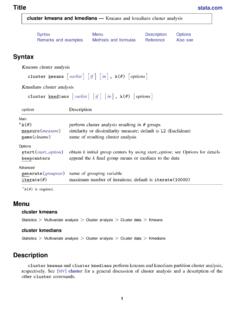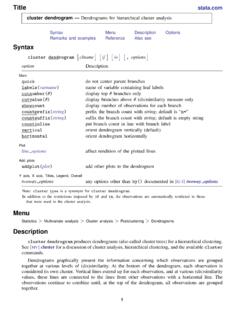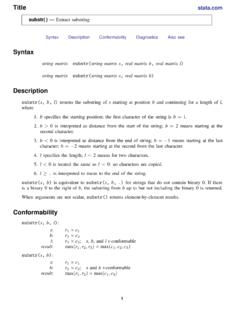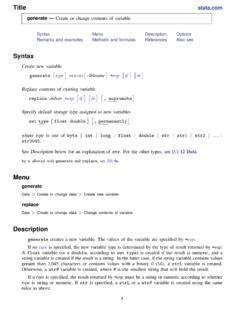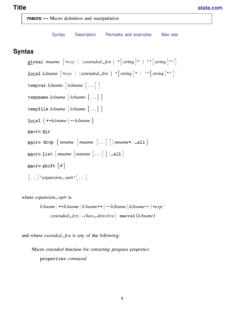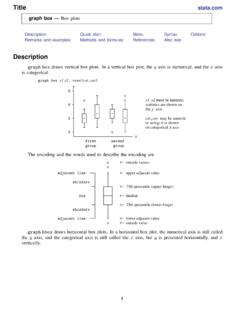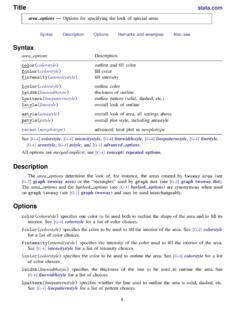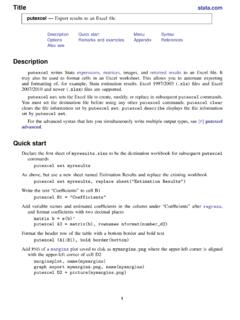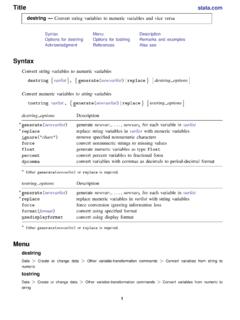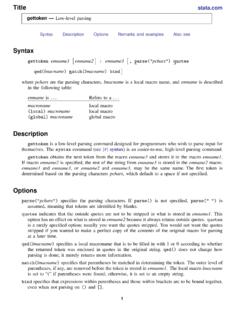Transcription of Mediation and interaction analysis Introduction and ...
1 Mediation and interaction analysisIntroduction and overview of Stata commandsAndrea BellaviaUtrecht Exposome Hub, Utrecht UniversityDepartments of Environmental Health, Harvard Chan School of Public Stata Biostatistics and Epidemiology Virtual Symposium@andreabellaviaMediation analysisFebruary 18, 20211 / 22 Outline1. Principles of Mediation and pathway analysis2. Overview of current approaches and STATA Classical (Baron & Kenny) Structural Equation Modeling Counterfactual approach to Mediation General approach (Imai)3. Extensions and current gaps4. Themed4waycommand (Rino Bellocco)@andreabellaviaMediation analysisFebruary 18, 20212 / 221. Principles of Mediation and pathway analysisMediation and pathway analysis attempts to elucidate the mechanismsunderlaying an observedX is the association generated?Does the association only exist for specific subgroups? Mediation and pathway analysis address the how question.
2 Interactionanalysis addressed the for whom question@andreabellaviaMediation analysisFebruary 18, 20213 / 22 Mediation analysis - formal definitionA mediator is a covariate that mediates the association between X and of the effect of X on Y is due to the fact that X causes M, which inturn causes Y@andreabellaviaMediation analysisFebruary 18, 20214 / 22We aim to disentangle the total effect of X on Y into a direct effect thatgoes through all possible pathways but M ..XYM.. and an indirect effect that goes through MXYM@andreabellaviaMediation analysisFebruary 18, 20215 / Classical approach to Mediation analysisA very basic approach for Mediation analysis is the difference method,based on fitting two regression models. LetXbe the exposure of interest,Ya continuous outcome,Ma potential mediators, andCa set ofconfounders:E[Y|x,c] = 0+ 1 x+ T2 cE[Y|x,m,c] = 0+ 1 x+ 2 m+ T3 cIf the effect of the exposure is considerably reduced when adjusting for themediator, this is taken as an indicator of Mediation .
3 @andreabellaviaMediation analysisFebruary 18, 20216 / 22In this context, the effect of the exposure in the first model isinterpreted as the total effect ofXonY, while the effect of theexposure in the model that also adjusts for the mediator is interpretedas the direct the total effect is the sum of direct and indirect, the latter istherefore derived by taking the difference of the Effect (TE)= 1 Direct Effect (DE)= 1 Indirect Effect (IE)=TE - DE= 1 1@andreabellaviaMediation analysisFebruary 18, 20217 / 22 Product methodThe traditional approach for Mediation analysis , introduced by Baron andKenny in 1986, is the product method. Two regression models are stillrequired, one for the effect of the exposure on the outcome while adjustingfor the mediator, and one for the effect of the exposure on the [Y|x,m,c] = 0+ 1 x+ 2 m+ T3 cE[M|x,c] = 0+ 1 x+ T2 cThe indirect effect is calculated by taking the product of the effect of theexposure on the mediators time the effect of the mediator on the Effect = 1 Indirect Effect = 1 2 Total Effect = DE+IE@andreabellaviaMediation analysisFebruary 18, 20218 / 22 Baron and Kenny (1986) showed that the two approaches comparewhen linear models are fitted (continuous outcome and mediator).
4 The product method however became the common choice as it canbe extended to binary as well as time-to-event outcomesStata does not have an official command for the Baron & Kennyapproach, which simply consists in estimating regression models andcombining coefficients (easily done withlincomandnlcom).@andreabellaviaMedia tion analysisFebruary 18, 20219 / Structural Equation Modeling frameworkStructural equation modeling (SEM) is a flexible framework toevaluate the relationship between several covariates, including latentvariables, generally based on generalized linear regression linking several covariates, SEM has been widely used to evaluatedirect dependencies among covariates (pathway analysis )This approach became very popular in economics and social sciences,but its use in epidemiology is limited by important assumptionincluding linearity, normality for all evaluated variables, and absenceof unmeasured confounding between all sets of evaluated covariates(Vanderweele 2012)
5 @andreabellaviaMediation analysisFebruary 18, 202110 / 22 SEM in StataThesemcommand allows conducting Mediation analysis as long as boththe dependent variable and the mediator variable are continuous variables(and all assumptions are met)The basic command is built on fitting the two regression models presentedbeforesem (M <- X C1 C2)(Y <- M X C1 C2)@andreabellaviaMediation analysisFebruary 18, 202111 / Counterfactual approach to Mediation analysisThe traditional and SEM approach to Mediation analysis share importantlimitations:1 First, if control is not made for the mediator-outcome confoundersthen results from the traditional approach to Mediation can be highlybiased2 Exposure-mediator interaction cannot be incorporated in thetraditional framework. On the other hand, if an interaction is reallypresent and ignored, direct and indirect effects will be addition, all continuous exposure and mediators are assumed tohave a linear effect.
6 Incorporating non-linearities in the traditionalapproach is not straigthforward.@andreabellaviaMediation analysisFebruary 18, 202112 / 22 These limitations can be addressed by evaluating Mediation analysiswithin a counterfactual framework (causal Mediation analysis ).This approach defines direct and indirect effects in terms of thecounterfactual intervention [ fixing exposure and mediator to apredefined value (controlled), or fixing the exposure to a predefinedvalue and the mediator to the value that naturally follows (natural)].The total effect decomposes into the sum of natural direct andindirect effectBroadly speaking, natural effects provide information on mechanisms,while controlled effects can be interpreted in terms of interventions@andreabellaviaMediation analysisFebruary 18, 202113 / 22 IdentificationCounterfactual objects can not be identified at the individual level(they would require observing an individual in both the real andcounterfactual world), but we are able to estimate such effects at thepopulation levels and by making a set of unmeasured exposure-outcome confounding given C2No unmeasured mediator-outcome confounding given C3No unmeasured exposure-mediator confounding given C4No effect of exposure that confounds the mediator-outcome relationshipNote that assumptions (1) and (3) are satisfied automatically if theexposure is randomized, but not (2) and (4).
7 Estimating the CDE only requires assumptions (1) and (2) to besatisfied.@andreabellaviaMediation analysisFebruary 18, 202114 / 22 Mediation analysis with exposure-mediator interactionWhen exposure-mediator interaction is present one of the three neededmodel must be modified as follows:E[Y|x] = 0+ 1 xE[Y|x,m] = 0+ 1 x+ 2 m+ 3 x mE[M|x] = 0+ 1 xIn this situation the formulas for direct and indirect effects previouslypresented do not yield valid using the counterfactual definition of direct and indirect effects,interactions can instead be taken into account, and formulas toestimate effects are available.@andreabellaviaMediation analysisFebruary 18, 202115 / 22 Four-way decomposition of the total effectVanderweele (2014) showed that, by using the counterfactualapproach, the total effect can be decomposed into four differentcomponents:Ia direct effect (controlled)Ia proportion due to Mediation alone (natural indirect effect)Ia proportion due to interaction alone (reference interaction )Ia proportion due to both Mediation and interaction (mediatedinteraction).
8 This 4-way decomposition provides the maximum insight on clarifyingthe contribution of interactive and mediating mechanisms to a givenobserved total effectComponentInterpretationCDET reatment effect neither due to Mediation nor interactionINTrefTreatment effect only due to interactionINTmedTreatment effect due to both Mediation and interactionNIET reatment effect only due to Mediation @andreabellaviaMediation analysisFebruary 18, 202116 / 22 Theparamedcommandparamed(Emsley et al., 2012) was the first Stata command to bedeveloped for conducting causal Mediation analysis allowing forexposure-mediator interactionBy using the optionnointer, the command produces results fromthat correspond to the ones obtained with the traditional install paramedparamed varname, avar(varname) mvar(varname) a0(real)a1(real) m(real) yreg(string) mreg(string)[cvars(varlist) nointeraction casecontrol fulloutputc(numlist) bootstrap reps(integer 1000) level(cilevel)seed(passthru)]@andreabell aviaMediation analysisFebruary 18, 202117 / General approach to Mediation analysisA more flexible simulation-based approach has been developed byImai et al (2010).
9 This allows to specify much more flexible models for the outcome andthe mediator and then to estimate the direct and indirect effects bysimulationThe approach makes the same confounding assumptions previouslydescribed but allows for more flexible modeling@andreabellaviaMediation analysisFebruary 18, 202118 / 22 Themedeffcommandmedeff(Hicks and Tingley, 2011) is the Stata command for implementingthis approach by Imai. It is based on the R package developed by theAuthors, and is computationally install mediationmedeff(regress m x c)(logit y m x mx c),mediate(m) treat(x)[interact(mx) sims(#) seed(#) vce() level()]Themediationpackage also includes amedsenscommand that allowsconducting sensitivity analysis @andreabellaviaMediation analysisFebruary 18, 202119 / 22 Recent extensions and current software gapsSeveral extensions have been developed over the last decade,primarily based on the counterfactual approach to Mediation analysisbut not onlyTo our knowledge, while most of these extensions are available in R,current Stata commands do not cover most of these recentextensions.
10 Because of the increasing interest in Mediation analysis ,there is a need to fill this gapWe recently developed themed4waycommand (focus of the nextpresentation), which integrates the analysis of survival outcomes andthe four-way decomposition of the total effects@andreabellaviaMediation analysisFebruary 18, 202120 / 22 Some critical topics that could/should be integrated include:Multiple mediators and interactions (Vanderweele & Vansteelandt2014, Bellavia & Valeri 2019)High-dimensional Mediation analysis (Blum et al. 2020)Time-varying exposures, mediators, and confounders (VanderWeele etal. (2017)Sensitivity analyses for the counterfactual approach (Vanderweele2010)Multiple imputations@andreabellaviaMediation analysisFebruary 18, 202121 / 22 ReferencesBellavia A, Valeri L. Decomposition of the total effect in the presence of multiplemediators and interactions. American journal of epidemiology.)
